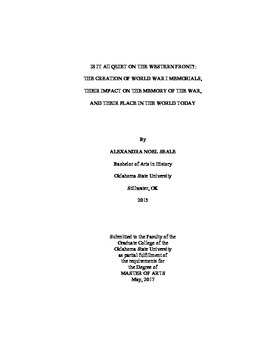| dc.contributor.advisor | Bryans, William S. | |
| dc.contributor.author | Seale, Alexandra | |
| dc.date.accessioned | 2018-03-13T18:16:23Z | |
| dc.date.available | 2018-03-13T18:16:23Z | |
| dc.date.issued | 2017-05-01 | |
| dc.identifier.uri | https://hdl.handle.net/11244/54609 | |
| dc.description.abstract | The Memory Boom of the last several decades has increased the creation of and the interest in public memory spaces. Memorials and monuments create physical places for the public to interact with history, but this is not a new phenomenon. World War I (WWI) was the first major conflict of the twentieth century and out of the war sprang a focus on war commemoration. World War I memorials were created in all of the countries involved in the conflict and each used specific imagery to represent their understanding and emotions toward the war. The United States is unique in its form of war commemoration as it was the country that took part in the war the shortest length of time. However, many of the same commemorative practices and styles exist in the United States as well as other countries. By looking at the United States, Britain, and France as examples of Western European styles of commemoration, with a focus on the Western Front of the war, cross-cultural and international sharing of memorial styles can be found. German and Russian memorials are examples of countries oriented more to the Eastern Front and how the war affected these cultures. By examining the construction and reason for creating these memorials, a better understanding of the place World War I has in the United States can be discerned. The United States is the only country out of those reviewed in this study that does not have a truly national WWI memorial. Commissions in the United States government are attempting to create such a memorial, but does such a memorial have a place in today�s society? Comparing all of these countries and their memorial construction augments the historical and public understanding of the war. With the centennial of World War I, the place of these structures today has been questioned and is being studied. This work uses a comparison of memorials and countries to find the place these memorials have today. | |
| dc.format | application/pdf | |
| dc.language | en_US | |
| dc.rights | Copyright is held by the author who has granted the Oklahoma State University Library the non-exclusive right to share this material in its institutional repository. Contact Digital Library Services at lib-dls@okstate.edu or 405-744-9161 for the permission policy on the use, reproduction or distribution of this material. | |
| dc.title | Is It All Quiet on the Western Front?: The Creation of World War I Memorials, Their Impact on the Memory of the War, and Their Place in the World Today | |
| dc.contributor.committeeMember | Kinder, John | |
| dc.contributor.committeeMember | Moses, L. G. | |
| osu.filename | Seale_okstate_0664M_15117.pdf | |
| osu.accesstype | Open Access | |
| dc.description.department | History | |
| dc.type.genre | Thesis | |
| dc.type.material | text | |
